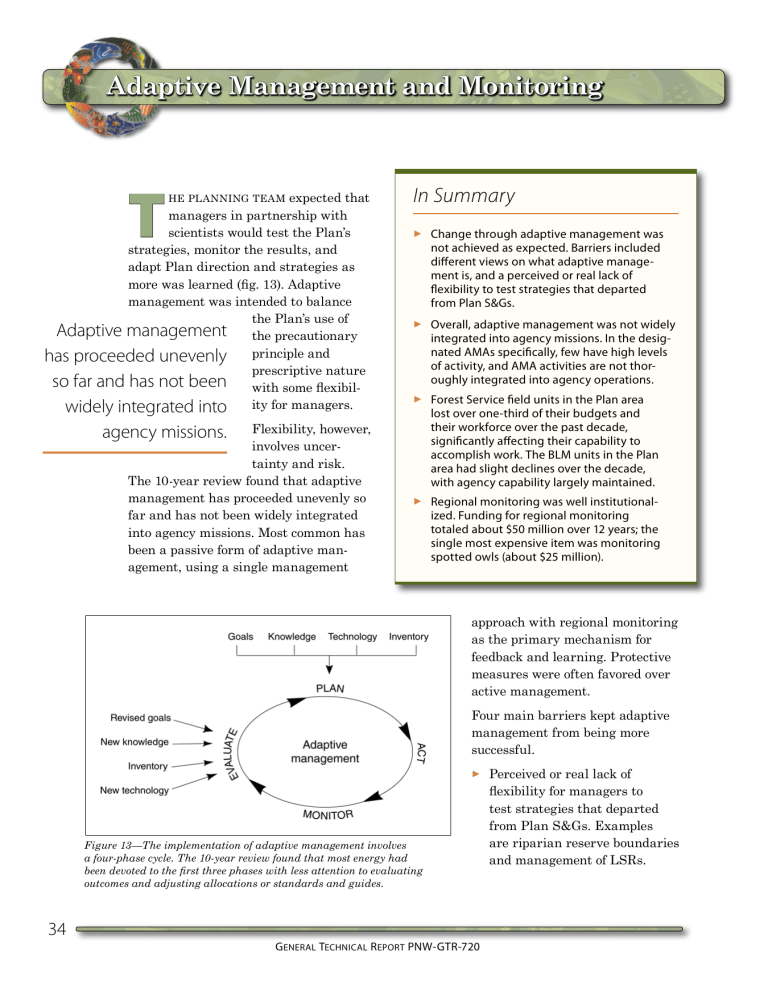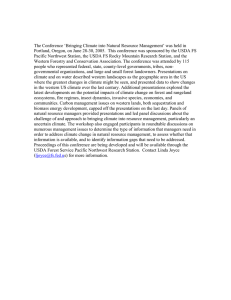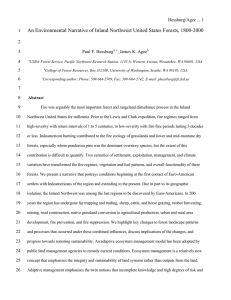T Adaptive Management and Monitoring In Summary
advertisement

Adaptive Management and Monitoring T expected that managers in partnership with scientists would test the Plan’s strategies, monitor the results, and adapt Plan direction and strategies as more was learned (fig. 13). Adaptive management was intended to balance the Plan’s use of Adaptive management the precautionary has proceeded unevenly principle and prescriptive nature so far and has not been with some flexibilwidely integrated into ity for managers. he planning team Flexibility, however, involves uncertainty and risk. The 10-year review found that adaptive management has proceeded unevenly so far and has not been widely integrated into agency missions. Most common has been a passive form of adaptive management, using a single management In Summary ► Change through adaptive management was not achieved as expected. Barriers included different views on what adaptive management is, and a perceived or real lack of flexibility to test strategies that departed from Plan S&Gs. ► Overall, adaptive management was not widely integrated into agency missions. In the designated AMAs specifically, few have high levels of activity, and AMA activities are not thoroughly integrated into agency operations. ► Forest Service field units in the Plan area lost over one-third of their budgets and their workforce over the past decade, significantly affecting their capability to accomplish work. The BLM units in the Plan area had slight declines over the decade, with agency capability largely maintained. ► Regional monitoring was well institutionalized. Funding for regional monitoring totaled about $50 million over 12 years; the single most expensive item was monitoring spotted owls (about $25 million). agency missions. approach with regional monitoring as the primary mechanism for feedback and learning. Protective measures were often favored over active management. Four main barriers kept adaptive management from being more successful. ► Figure 13—The implementation of adaptive management involves a four-phase cycle. The 10-year review found that most energy had been devoted to the first three phases with less attention to evaluating outcomes and adjusting allocations or standards and guides. 34 G eneral Technical R eport PNW-GTR-720 Perceived or real lack of flexibility for managers to test strategies that departed from Plan S&Gs. Examples are riparian reserve boundaries and management of LSRs. Adaptive management areas Olympic AMA I-5 Major lakes and rivers I-90 Snoqualmie Pass AMA I-9 States 0 Finney AMA Seattle Northwest Forest Plan area Major roads Metropolitan areas I-5 Cispus AMA Portland I-82 I-84 I-84 Northern Coast Range AMA I-5 Central Cascades AMA Little River AMA Applegate AMA Goosenest AMA I-5 Hayfork AMA o 0 25 50 I-80 100 Miles San Francisco About 1.5 million acres (6 percent of the Plan area) were included in 10 designated AMAs, which were given a special mandate to test new ideas and management approaches. Although several highly relevant research projects were carried out, successes and lessons from the AMAs were not communicated widely. Large-scale management experiments happened in only a few AMAs. For example, the Little Horse Peak Project in the Goosenest AMA (California) tested different combinations of silvicultural treatments (especially tree harvest and prescribed fire) and their success in accelerating the development of oldforest attributes in mixed stands of ponderosa pine and white fir. The Blue River Landscape Study in the Central Cascades AMA (Oregon) is testing a landscape management strategy based on a disturbance ecology approach, which involves deviations from the Plan’s standards and guidelines. 35 N orthwest Forest Plan —The First 10 Years (1994–2003): First-D ecade R esults of the N orthwest Forest Plan Some adaptive management processes have occurred. One is the modified survey and manage program for rare species. Survey schedules, species classifications, and management requirements were changed for a number of these species in response to new information. Regional Monitoring Program One example of successful adaptive management was the use of new science information in managing even-aged plantations in latesuccessional reserves (LSRs). Studies showed that thinning these second-growth stands, along with other techniques, could speed the development of older forest characteristics. Such thinnings became a major source of timber in some federal forests, benefiting local economies and moving stands toward the old-forest habitat. ► ► he regional monitoring program was to be a key part of the adaptive management cycle, with a dual role of measuring progress and advancing learning. Regional monitoring was well institutionalized, with agencies committing resources and a full-time team to the program (fig. 14). Monitoring Caution about the burden of proof for modifying S&Gs prevented adapting some active management even in cases with apparent benefits, such as reducing fire risk in fire-prone areas. Insufficient resources to carry out adaptive management. Forest Service field units in the Plan area lost more than one-third of their budgets and workforce over the decade, about onequarter of Forest Service field offices closed or consolidated, and contracts for ecosystem management work dropped nearly 70 percent. The number of BLM employees in the Plan area declined slightly over the decade, and BLM capability was maintained. Perception of adaptive management as limited to a public participation process or a way to create new partnerships. Although new partnerships were created in some areas, many had lost momentum by the end of the decade. 60,000 50,000 Thousand dollars ► T 40,000 Total Monitoring Costs 1994–2005 Program management Socioeconomics Tribal Tribal Biodiversity Biodiversity Socioeconomics Implementation Watersheds Older forests 30,000 Marbled murrelet 20,000 Spotted owl 10,000 0 By monitoring module Figure 14—The single most expensive monitoring module during the Plan’s first decade was monitoring of spotted owl populations (about $25 million). Marbled murrelet and watershed conditions were the next two most expensive modules. 36 G eneral Technical R eport PNW-GTR-720 produced a wealth of data, culminating in a series of status and trend reports, the 10-year review, and a science synthesis. Reports are listed in the “References and CD-ROM Contents” section on page 40 and are included as PDF files on the CD-ROM bound in this publication. owl monitoring had been going on since well before the Plan. Monitoring protocols had to be developed for some resources and were phased in as available: late-successional and oldgrowth forests (1998), marbled murrelets (1999), socioeconomic monitoring (2002), tribal consultation (2004), watershed condition (2004). Three distinct types of monitoring were identified. ► ► Implementation monitoring. Verifies that the specified activities actually take place. A full implementation monitoring program began in 1996. Effectiveness monitoring. Evaluates if the specified activities actually accomplish the goals. Spotted ► Validation monitoring. Evaluates if a cause and effect relationship exists between management actions and outcomes. The federal agencies involved in the Plan spent about $50 million on regional monitoring over 12 years, about 12 percent of the total cost of implementing the Plan. ■ 37 N orthwest Forest Plan —The First 10 Years (1994–2003): First-D ecade R esults of the N orthwest Forest Plan Looking Ahead: Challenges for the Next 10 Years T 10-year review suggests that the overall framework of the Plan is working, but certain improvements are needed to meet all the Plan’s goals. The Plan’s most notable successes are the protection of old-growth and riparian forests and associated species. Certain Most existing old-growth stands improvements are now protected from future harvest, and other middle-aged are needed to stands are slowly developing meet all the older-forest characteristics such as large trees. Watersheds are being Plan’s goals. restored, roads decommissioned, and rare species are protected. he In Summary ► The Plan’s most notable successes are the protection of old-growth and riparian forests and associated species. ► Cooperation improved among agencies and between research and management. ► Timber harvests were lower than expected and few new, year-round, high-wage jobs were created in communities hit hard by timber shortfalls. ► Active fuels management in the fire-prone forests of the eastern Cascade Range and Klamath-Siskiyou regions lagged behind expectations. ► The Plan’s conservation strategies are tightly connected, making it difficult to modify one without potentially compromising other strategies. ► The term “forest-based” includes a sense of place, recreation values, and other amenities that connect communities with forests, along with a timber economy. New partnerships forged among managers, scientists, and the public are likely to yield new ideas to be tested in managing forests. Yet the Plan fell short in some areas. Timber harvests were lower than expected and few new, year-round, high-wage jobs were created in communities hit hard by timber shortfalls. Active fuels management in the fire-prone forests of the eastern Cascade Range and Klamath-Siskiyou regions lagged behind expectations, perhaps increasing the risk of severe fire in these areas. However, fire losses averaged over the Plan area thus far are consistent with projections made at the outset. The Plan was not entirely successful in ending gridlock or controversies about federal land management. The 10-year review found that the Plan’s science base generally held up well, but some new scientific ideas emerged. Forest and stream ecosystems are more highly dynamic and have more variability than was recognized a decade ago. Thus fixed reserves may not be the best long-term strategy for conserving biodiversity, especially in fire-prone provinces. For ecosystems that change constantly under both natural and managed conditions, the most important characteristic may be the ability to recover after a disturbance. 38 G eneral Technical R eport PNW-GTR-720 Challenges for the Next 10 Years ► Emerging issues such as climate change and invasive species. ► The risk of high-severity fires in the dry, fire-prone provinces. ► Issues related to postfire management, including salvage logging. ► Comprehensive strategy for managing forest ecosystems of all ages and types. ► Integration of regional Plan direction with expert knowledge of local conditions. ► Maintenance of technical expertise across multiple disciplines in field units. ► Issues related to the key watersheds network, management direction for key watersheds, and watershed restoration priorities. ► Real or perceived barriers to testing new approaches and taking measured risks to meet challenges such as large fires. ► Real or perceived barriers to diversifying practices to meet local conditions. ► Objective ways to measure ecosystem resilience and adaptation to climate change and other disturbances. ► Greater collaboration with tribes, the public, and among agencies. ► Improvements in the management of information, especially accessibility and consistency. Tom Iraci The 10-year review concluded with a look ahead at the next decade’s challenges for the Plan. “It is our collective and individual responsibility to protect and nurture the global family, to support its weaker members, and to preserve and tend to the environment in which we all live.” —Tenzin Gyatso (the Dalai Lama) 39 N orthwest Forest Plan —The First 10 Years (1994–2003): First-D ecade R esults of the N orthwest Forest Plan References and CD-ROM Contents Baker, D.; Ferguson, G.; Palmer, C.; Tolle, T. 2005. Northwest Forest Plan—the first 10 years (1994–2003): Implementation monitoring: summary of regional interagency monitoring results. Tech. Paper R6-RPM-TP-042005. Portland, OR: U.S. Department of Agriculture, Pacific Northwest Region. http://www.reo.gov/monitoring/ reports/10yr-report/implementation/ CPImpleMoniFirstTenYears1-23-06.pdf. (23 January 2008). Charnley, S., tech. coord. 2006. Northwest Forest Plan—the first 10 years (1994–2003): socioeconomic monitoring results. Gen. Tech. Rep. PNW-GTR649. Portland, OR: U.S. Department of Agriculture, Pacific Northwest Research Station. 6 vol. Donoghue, E.; Sutton, L. 2006. Community socioeconomic information system: making socioeconomic data available at the community level. [CD-ROM.] Gen. Tech. Rep. PNW-GTR-672. Portland, OR: U.S. Department of Agriculture, Pacific Northwest Research Station. Haynes, R.W.; Bormann, B.T.; Lee, D.C.; Martin, J.R., tech. eds. 2006. Northwest Forest Plan—the first 10 years (1994–2003): a synthesis of monitoring and research results. Gen. Tech. Rep. PNW-GTR-651. Portland, OR: U.S. Department of Agriculture, Pacific Northwest Research Station. 292 p. Huff, M.H.; Raphael, M.G.; Miller, S.L. [et al.], tech. coords. 2006. Northwest Forest Plan—the first 10 years (1994– 2003): status and trends of populations and nesting habitat for the marbled murrelet. Gen. Tech. Rep. PNW-GTR650. Portland, OR: U.S. Department of Agriculture, Pacific Northwest Research Station. 149 p. Interagency Regional Monitoring Program in the Pacific Northwest. Comprehensive collection of monitoring reports and data analysis, evaluating the success of the Northwest Forest Plan over its first 10 years. http://www.reo. gov/monitoring/reports/10yr-report/. (23 January 2008). Forest Ecosystem Management Assessment Team [FEMAT]. 1993. Forest ecosystem management: an ecological, economic, and social assessment. Portland, OR: U.S. Department of Agriculture; U.S. Department of the Interior [and others]. [Irregular pagination]. Lint, J., tech. coord. 2005. Northwest Forest Plan—the first 10 years (1994– 2003): status and trends of northern spotted owl populations and habitat. Gen. Tech. Rep. PNW-GTR-648. Portland, OR: U.S. Department of Agriculture, Pacific Northwest Research Station. 176 p. Gallo, K.; Lanigan, S.H.; Eldred, P. [et al.]. 2005. Northwest Forest Plan— the first 10 years (1994–2003): preliminary assessment of the condition of watersheds. Gen. Tech. Rep. PNW-GTR647. Portland, OR: U.S. Department of Agriculture, Pacific Northwest Research Station. 133 p. Moeur, M.; Spies, T.A.; Hemstrom, M. [et al.]. 2005. Northwest Forest Plan—the first 10 years (1994–2003): status and trend of late-successional and old-growth forest. Gen. Tech. Rep. PNWGTR-646. Portland, OR: U.S. Department of Agriculture, Pacific Northwest Research Station. 142 p. 40 G eneral Technical R eport PNW-GTR-720 Stuart, C.; Martine, K., tech. eds. 2006. Northwest Forest Plan—the first 10 years (1994–2003): Effectiveness of the federal-tribal relationship. Tech. Paper R6-RPM-TP-02-2006. Portland, OR: U.S. Department of Agriculture, Pacific Northwest Region. http://www.reo.gov/ monitoring/reports/10yr-report/tribal/ Tribal_Draft.pdf. (23 January 2008). Tom Iraci U.S. Department of Agriculture, Forest Service, Pacific Northwest Research Station. http://www.fs.fed. us/pnw/. This site accesses electronic information about all Pacific Northwest Research Station research. (6 July 2005). U.S. Department of Agriculture, Forest Service; U.S. Department of the Interior, Bureau of Land Management [USDA and USDI]. 1994. Record of decision for amendments to Forest Service and Bureau of Land Management planning documents within the range of the northern spotted owl. [Place of publication unknown]. 74 p. [plus attachment A: standards and guidelines]. 41 N orthwest Forest Plan —The First 10 Years (1994–2003): First-D ecade R esults of the N orthwest Forest Plan Tom Iraci 42 G eneral Technical R eport PNW-GTR-720 Pacific Northwest Research Station Web site Telephone Publication requests FAX E-mail Mailing address http://www.fs.fed.us/pnw (503) 808-2592 (503) 808-2138 (503) 808-2130 pnw_pnwpubs@fs.fed.us Publications Distribution Pacific Northwest Research Station P.O. Box 3890 Portland, OR 97208-3890 U.S. Department of Agriculture Pacific Northwest Research Station 333 SW First Avenue P.O. Box 3890 Portland, OR 97208-3890 Official Business Penalty for Private Use, $300


